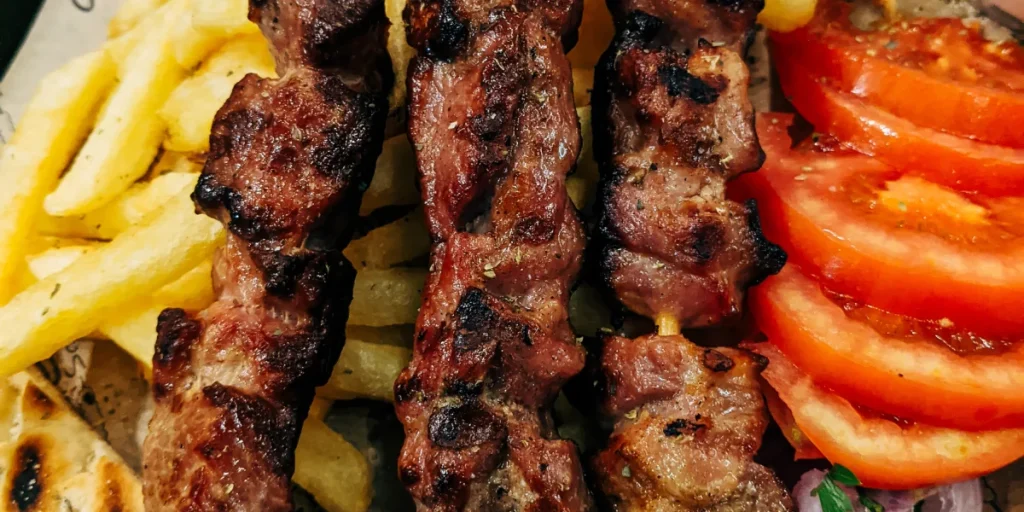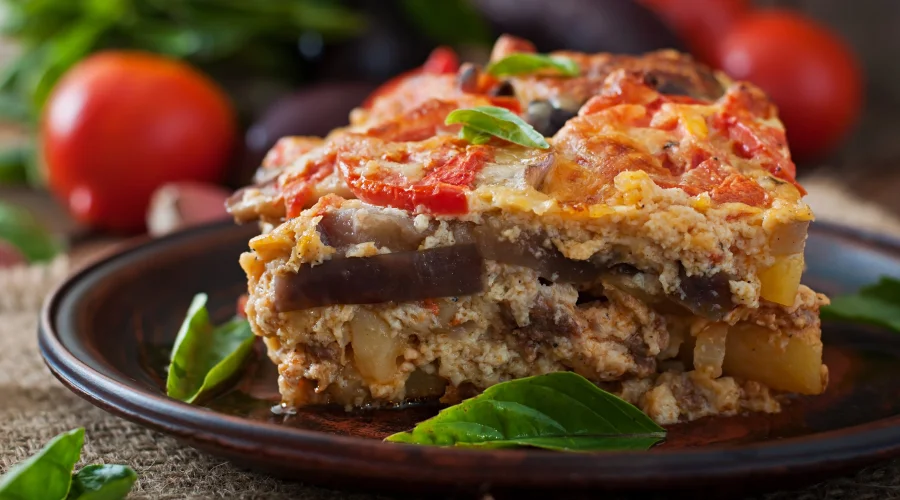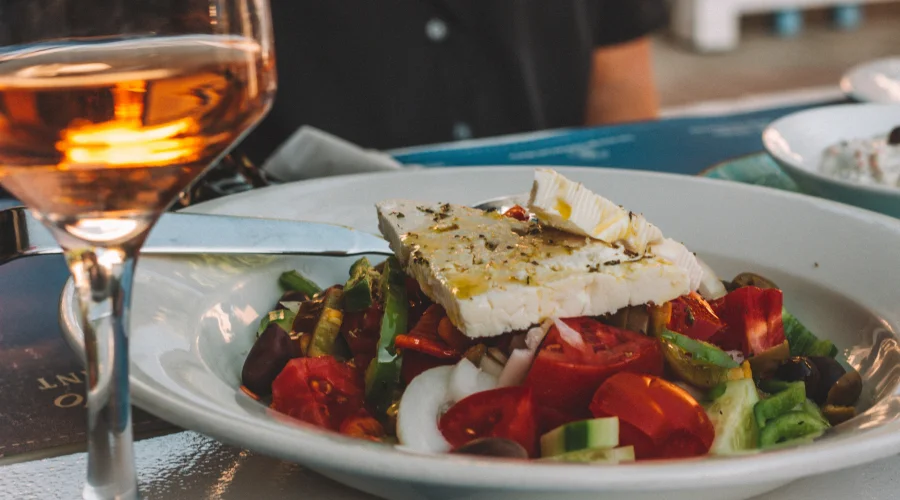
Athens, the vibrant capital of Greece, is not only a cradle of history and culture but also a gastronomic paradise. The city’s culinary scene is a delightful fusion of ancient traditions and modern tastes. Here’s a culinary journey through Athens, where you can’t miss indulging in these typical Greek dishes and delicacies.
Moussaka: A Hearty Classic
Moussaka is the epitome of Greek comfort food. This layered dish typically includes eggplant, minced meat (often lamb or beef), potatoes, and a creamy béchamel sauce. It’s then baked to perfection, resulting in a rich and hearty casserole. Moussaka is a must-try, and each bite is a taste of Greek tradition.
A Taste of Tradition
Moussaka is more than just a dish; it’s a culinary tradition that has been passed down through generations. Its origins can be traced back to the Middle East, where variations of this dish were made with eggplants and ground meat, eventually making their way to Greece. Today, it’s considered one of Greece’s national dishes, celebrated for its hearty and satisfying flavors.
At its core, Moussaka is a layered casserole composed of three main components: eggplant, ground meat (usually lamb or beef), and a creamy béchamel sauce. It’s this combination of ingredients that makes Moussaka a harmonious symphony of flavors and textures.
The Eggplant Base
The eggplant serves as the foundation of Moussaka. It’s traditionally sliced into rounds, salted to remove excess moisture, and then fried to a golden brown. This process not only adds a delicate smokiness to the dish but also brings out the eggplant’s natural sweetness.
The Meaty Layer
The meat layer of Moussaka is typically made with ground lamb or beef, cooked with onions, garlic, and a blend of Mediterranean spices. The use of ground meat adds a hearty, savory element to the dish, making it a satisfying meal.
The Creamy Crown
The pièce de résistance of Moussaka is the creamy béchamel sauce that blankets the meat and eggplant layers. This velvety topping is made from butter, flour, and milk, creating a rich and decadent finish to the dish. Once baked, it forms a golden crust that adds a delightful contrast to the savory layers beneath.
A Symphony of Spices
Greek cuisine is renowned for its use of aromatic spices, and Moussaka is no exception. Cinnamon, allspice, and nutmeg are common seasonings used in the meat layer, creating a warm and fragrant backdrop to the dish. These spices are what give Moussaka its distinct and enticing flavor.
After the layers are meticulously assembled, the entire dish is baked until it reaches a state of culinary perfection. The process allows the flavors to meld, the textures to harmonize, and the aromas to fill the kitchen, creating a tantalizing experience for the senses.
A Culinary Ambassador
Moussaka has transcended its Greek origins to become a beloved dish worldwide. It has found its way onto the menus of Mediterranean restaurants, dinner tables, and international cookbooks. Its rich flavors and comforting appeal have made it a cherished dish in many parts of the world.
Moussaka is not just a meal; it’s a culinary masterpiece that embodies the rich heritage and flavors of Greek cuisine. With its layers of smoky eggplant, spiced meat, and creamy béchamel, it’s a dish that offers a true taste of the Mediterranean. Moussaka is an experience to savor, a testament to the culinary artistry of Greece, and a delicious way to explore the traditions and flavors of this beautiful country. Whether enjoyed in a Greek taverna or prepared at home, Moussaka is a dish that leaves a lasting impression and a longing for more.

Souvlaki: The Quintessential Greek Street Food
Souvlaki is the quintessential Greek fast food. These bite-sized skewers of marinated and grilled meat, usually served in pita bread with toppings like tomatoes, onions, and tzatziki sauce, are perfect for a quick and satisfying meal. Whether it’s chicken, pork, or lamb, souvlaki is a Greek culinary staple.
Souvlaki is more than just a fast-food favorite; it’s a dish deeply rooted in Greek culinary tradition. The name “Souvlaki” itself means “little skewers” in Greek, and these bite-sized morsels have been a popular delicacy for centuries. While the exact origins of Souvlaki are debated, it’s clear that this delicious street food has been a part of Greek culture for generations.
The Makings of Souvlaki: At the heart of Souvlaki are the skewers of marinated meat, most commonly pork, but also chicken, lamb, or beef. The meat is typically cut into small cubes, seasoned with a mixture of olive oil, lemon juice, garlic, and an array of aromatic herbs and spices. This marinade infuses the meat with rich Mediterranean flavors and tenderizes it, making each bite incredibly savory.
The marinated meat is threaded onto skewers and then grilled to perfection. The open flames infuse the meat with a smoky, charred flavor while keeping it tender and juicy. It’s this grilling process that imparts the distinctive character of Souvlaki.
Souvlaki is traditionally served wrapped in a warm, soft pita bread, creating a portable and convenient meal. The pita acts as a delicious vessel for the skewers and toppings. The typical toppings for Souvlaki include slices of ripe tomatoes, crisp lettuce, red onions, and a generous dollop of tangy Tzatziki sauce – a yogurt-based sauce infused with garlic and cucumber.
Variations and Regional Flavors: While the classic Souvlaki is made with marinated meat, the dish has evolved to include various regional and modern variations. Vegetarian versions are available, featuring grilled vegetables or halloumi cheese. Regional specialties like Kalamaki, where the meat is served without the pita, offer a unique twist on the classic.
A Street Food Sensation: Souvlaki isn’t just a meal; it’s a street food sensation. In Greece, Souvlaki vendors can be found on almost every corner, serving up these delectable skewers to locals and tourists. The irresistible aroma of grilling meat wafts through the air, drawing in hungry passersby, creating a bustling and convivial atmosphere.
An International Icon: Souvlaki has transcended its Greek origins to become a beloved street food worldwide. From the streets of New York City to the markets of Istanbul, Souvlaki is celebrated for its delicious simplicity. Its appeal lies in its ability to capture the spirit of Greek cuisine in a convenient and accessible form.
Souvlaki is more than just a quick meal; it’s a culinary connection to the heart of Greek culture. It embodies the flavors, traditions, and conviviality of Greece, offering a delightful taste of the Mediterranean. Whether enjoyed from a street vendor in Athens, a seaside taverna in a Greek island, or at home, Souvlaki is a dish that brings people together, creating a shared experience and a memorable connection to the culinary soul of Greece.

Tzatziki: A Cool and Creamy Delight
Tzatziki is a refreshing and tangy yogurt-based dip, perfect for dipping pita bread or as a condiment for grilled meats. Made with strained yogurt, cucumber, garlic, and fresh herbs like dill or mint, it’s a cooling accompaniment to balance the flavors of many Greek dishes.
A Greek Culinary Classic: Tzatziki is a classic Greek sauce or dip known for its cool and refreshing taste. It is a crucial element in many traditional Greek dishes and serves as a versatile condiment that pairs well with a wide range of foods.
Tzatziki’s primary ingredients are plain Greek yogurt, cucumber, garlic, olive oil, and various seasonings. These simple elements come together to create a sauce that is greater than the sum of its parts.
Preparation and Flavor: To make Tzatziki, cucumber is finely grated and mixed with yogurt. This creates a base that is rich, tangy, and creamy. To this, crushed garlic, olive oil, lemon juice, and a medley of fresh herbs, such as dill and mint, are added. The result is a harmonious blend of flavors with a refreshing, garlicky kick.
Tzatziki is incredibly versatile and can be served with a wide array of dishes. It’s a classic accompaniment for grilled meats, such as Souvlaki, Gyros, and grilled lamb. It’s also a perfect dip for pita bread or vegetables and a fantastic topping for baked potatoes or roasted vegetables. Tzatziki is so adaptable that it can be used as a sauce for burgers or as a dressing for salads, making it an essential condiment for many Mediterranean-inspired meals.
A Refreshing Treat: What makes Tzatziki stand out is its ability to bring a refreshing contrast to the richness of many Greek dishes. The combination of cool yogurt and cucumber with the sharpness of garlic offers a delightful counterbalance. It’s particularly welcome during the hot summer months, providing a cooling effect that complements warm-weather meals.
A Worldwide Favorite: Tzatziki has not remained confined to Greece; it has gained popularity worldwide. It is often found in Mediterranean and Middle Eastern cuisines, served with dishes like kebabs, falafel, and shawarma. In recent years, it has also found its way into international cuisine, from sandwiches to wraps, as a healthy and flavorful dressing or dip.
Tzatziki is not just a sauce; it’s a taste of Greece. Its cool and creamy texture, combined with the zesty punch of garlic, brings a burst of Mediterranean flavor to every dish it accompanies. Whether you’re dining in a Greek taverna, enjoying a kebab from a food cart, or crafting your own culinary creations at home, Tzatziki is an essential addition that elevates the dining experience and leaves a lasting impression. With its refreshing and versatile character, Tzatziki is a delightful part of Greek cuisine that continues to be cherished worldwide.

Spanakopita: The Greek Spinach Pie
Spanakopita is a savory pie that combines flaky layers of phyllo pastry with a filling of spinach, feta cheese, onions, and herbs. Baked to a golden perfection, this dish is a delightful blend of crispiness and earthy flavors. It’s a great choice for a light meal or snack.
A Taste of Greece: Spanakopita, pronounced “span-a-KO-pee-ta,” is a classic Greek dish that has earned a place of honor in the world of Mediterranean cuisine. The name “Spanakopita” is a combination of two Greek words: “spanaki,” which means spinach, and “pita,” which means pie. The dish is a flavorful and flaky pastry filled with a mixture of spinach, herbs, and feta cheese.
The Ingredients of Spanakopita: Spanakopita’s key ingredients include phyllo dough, spinach, feta cheese, onions, garlic, olive oil, and a medley of aromatic herbs and spices. These ingredients come together to create a harmonious fusion of flavors and textures.
The Making of the Filling: The filling is where the magic happens. Fresh spinach is sautéed with onions and garlic until wilted and tender. It’s then combined with crumbled feta cheese, fresh herbs such as dill or parsley, and seasonings like nutmeg and black pepper. The mixture is a tantalizing combination of earthy greens, creamy cheese, and fragrant herbs.
Phyllo dough is the star of the show when it comes to Spanakopita’s flaky, golden exterior. This paper-thin pastry is typically brushed with olive oil or melted butter, then layered to create a delicate, flaky crust. The filling is nestled between layers of phyllo, which, when baked, become golden and crisp, offering a delightful contrast to the savory interior.
Versatility and Creativity: Spanakopita’s versatility extends beyond its traditional recipe. While spinach is the most common filling, this Greek savory pie can be adapted to suit personal preferences. Other greens like Swiss chard or kale can be used, and additional ingredients such as pine nuts or sun-dried tomatoes can be added to create unique variations.
Serving Spanakopita: Spanakopita is typically served as an appetizer, snack, or even a main dish, depending on the portion size. It can be enjoyed warm or at room temperature, making it suitable for picnics, parties, or casual dining. Many Greek restaurants offer Spanakopita on their appetizer menus, and it’s often found at Greek festivals and gatherings.
Spanakopita is not just a dish; it’s a culinary delight that represents the heart and soul of Greek cuisine. With its flaky phyllo layers, rich spinach and cheese filling, and aromatic herbs and spices, it embodies the essence of Mediterranean flavors. Whether enjoyed at a family gathering, a Greek restaurant, or prepared at home, Spanakopita is a dish that brings joy, comfort, and a true taste of Greece to those who savor it.

Greek Salad: Fresh and Flavorful
A Greek salad is a refreshing and healthy side dish made with simple yet flavorful ingredients. It typically includes ripe tomatoes, cucumbers, red onions, Kalamata olives, feta cheese, and oregano, all drizzled with extra-virgin olive oil. It’s a perfect complement to any Greek meal.
The Greek salad, or Horiatiki, is a quintessential Mediterranean dish that has become a global favorite. It’s celebrated for its vibrant presentation, robust flavors, and the use of fresh, seasonal ingredients.
Key Ingredients: The key ingredients of a traditional Greek salad include:
- Tomatoes: Ripe, juicy tomatoes are a foundation of the salad. Their sweetness and acidity provide a refreshing contrast to other elements.
- Cucumbers: Crisp and mild cucumbers add a pleasant crunch to the salad.
- Red Onions: Sliced red onions provide a hint of pungency and a beautiful pop of color.
- Green Bell Peppers: These peppers are mild and slightly sweet, contributing to the salad’s freshness.
- Kalamata Olives: These dark, almond-shaped olives are a Mediterranean delicacy, known for their rich, briny flavor.
- Feta Cheese: Feta cheese is a crucial element, offering a creamy, tangy, and slightly salty component.
- Extra Virgin Olive Oil: A drizzle of high-quality olive oil enhances the salad’s flavors and adds richness.
- Dried Oregano: A sprinkling of dried oregano is the finishing touch, infusing the salad with a distinctive aroma and flavor.
Variations and Additions: While the classic Greek salad includes the ingredients mentioned above, regional and personal variations are common. Some people add fresh basil, capers, or anchovies for extra layers of flavor. Others may include lettuce or arugula to create a bed for the salad.
Greek salad is not just a dish; it’s a celebration of freshness and flavor. It embodies the essence of Mediterranean cuisine, with its focus on wholesome ingredients, bold flavors, and a joyful presentation. Whether enjoyed as a side dish, a light lunch, or a complete meal, Greek salad offers a taste of Greece’s vibrant culinary culture. With its ripe tomatoes, crisp cucumbers, briny olives, and creamy feta cheese, it’s a delightful and refreshing experience that brings the sunny Mediterranean to your plate.

Baklava: Sweet Layers of Bliss
Baklava is a delectable Greek dessert that’s as rich in flavor as it is in history. It consists of layers of phyllo dough, butter, chopped nuts (often walnuts or almonds), and a sweet syrup or honey. The result is a sweet, sticky, and crunchy dessert that satisfies any sweet tooth.
Baklava is a sweet pastry that has been enjoyed for centuries across the Middle East, the Balkans, and Mediterranean countries. Its exact origins are a matter of debate, with various regions laying claim to this delightful dessert. Regardless of its beginnings, Baklava is cherished as a symbol of hospitality and celebration in many cultures.
The Layers of Creation: At the heart of Baklava is a labor of love involving layers of phyllo (or filo) dough, a mixture of finely chopped nuts, and a sweet syrup. The process begins with thin sheets of phyllo dough, which are layered one by one and brushed with melted butter. Between these layers, a mixture of ground nuts, often walnuts, pistachios, or almonds, is generously spread. This nut filling provides a delightful crunch and earthy richness.
Baklava is all about the art of layering. Each sheet of phyllo dough is carefully placed, brushed with butter, and repeated until there are multiple layers. This meticulous layering creates the pastry’s signature flakiness, with the butter and nuts melding into a delicious combination.
Aromatic Spices: Aromatic spices such as cinnamon and cloves are often sprinkled among the layers, adding a fragrant dimension to the dessert. These spices infuse Baklava with warmth and complexity, further enhancing its delightful taste.
Once the layering is complete, the pastry is cut into desired shapes, often diamond or square pieces, and baked to golden perfection. After baking, the hot Baklava is drenched in a sweet syrup made from sugar, water, and sometimes lemon juice or orange blossom water. This syrup seeps into the layers, transforming the pastry into a gooey, sweet delight.
A Dessert of Celebration: Baklava is often associated with special occasions and celebrations. In many cultures, it is served during festive gatherings, weddings, and holidays. Its indulgent sweetness and exquisite presentation make it a perfect choice for marking joyous moments.
Baklava is not just a dessert; it’s a culinary treasure that showcases the rich heritage of Mediterranean and Middle Eastern cuisine. With its intricate layers, nutty richness, and syrupy sweetness, Baklava offers a delightful journey for the senses. Whether enjoyed as a small indulgence or part of a grand celebration, Baklava is a symbol of the joy and sweetness of life. It’s a dessert that brings people together, creating moments of shared bliss and a love for the culinary traditions that span generations.

Conclusion
Athens offers a mouthwatering journey through Greek cuisine. From the rich and comforting layers of moussaka to the street food satisfaction of souvlaki, every bite in this city is a taste of Greece’s culinary heritage. Be sure to explore the numerous tavernas, restaurants, and markets that grace Athens, where you can immerse yourself in a world of delicious Greek flavors. Dining in Athens is not just about eating; it’s a cultural experience that will leave you with a deep appreciation for the rich tapestry of Greek gastronomy.
More information
The Parthenon is an iconic symbol of ancient Greek civilization and a masterpiece of classi…
On Athens’ Acropolis, there is a stunning and well-known ancient Greek temple called…



